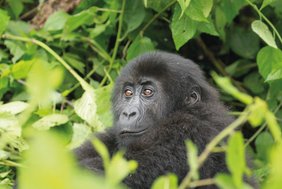Dear Relatives
Categories: Journal, Ausgabe 68, Taxonomy, Mountain Gorilla, Grauer's Gorilla, Cross River Gorilla, Taxonomy
Are the Virunga Mountain Gorillas' closest relatives the Bwindi Mountain Gorillas?
Gorillas are subdivided into two species and four subspecies. In recent years, habitat loss, poaching and disease outbreaks have led to three of the four subspecies being listed as Critically Endangered by the IUCN (International Union for Conservation of Nature) Red List. Genome-wide sequencing is greatly expanding our knowledge of wild species. It provide insights into population structure, diversity, evolutionary history and local ecological adaptation being crucial for current and future conservation efforts, as it can be used to identify endangered populations and develop effective conservation measures.
A recently published genome-based study on the evolutionary history of gorillas found that western gorillas (Gorilla gorilla) and eastern gorillas (Gorilla beringei) diverged around 150,000-180,000 years ago. Further splits into today's subspecies occurred within the western gorillas around 80,000 years ago (western lowland gorillas and Cross River gorillas), while the eastern gorilla subspecies (mountain gorillas and Grauer's gorillas) separated only 10,000-20,000 years ago. It is generally thought that the ancestors of the Grauer's gorillas and mountain gorillas split first, followed by the separation of the two mountain gorilla populations, Bwindi and Virunga.
However, a striking finding of the new study is the closer genetic relationship between Grauer's and Virunga mountain gorillas than between Virunga and Bwindi mountain gorillas. In addition, the genetic analyses provide evidence for subsequent gene flow among populations with evidence of genetic admixture between Cross River gorillas and Grauer's gorillas around 9,000-12,500 years ago and even after the latter diverged into Grauer's and mountain gorillas. Given the current distribution, this observation may seem surprising at first. However, the results can be reconciled with changing environmental conditions during the last ice age and subsequent humid climatic periods in Africa. These climatic changes could have favoured the expansion and contraction of gorilla territories.
The authors of the study propose the following scenario: After the split between western and eastern gorillas, but before the Last Glacial Maximum (50,000-26,000 years ago), eastern gorillas had a wide range that covered large parts of East Africa. During the Last Glacial Maximum (26,000-20,000 years ago), the landscape changed due to lower temperatures, less rain and decreasing humidity. Forests became savannahs and lakes dried up. This change led to the separation of the Virunga and Bwindi mountain gorillas. When humidity increased again (around 14,500 years ago), lakes filled and forests expanded, enabling the Virunga gorillas to spread into areas inhabited by Grauer's gorillas today. At the same time, the Cross River gorillas spread eastwards, resulting in genetic exchange with the ancestors of today's Grauer's gorillas. After the end of the wet period (6000-5000 years ago), there was a further decline in suitable habitat, leading to isolation between populations. Anthropogenic influences have exacerbated this.
The research team also found that western gorillas exhibit higher genetic diversity than eastern gorillas. However, the very small population size of the Cross River gorillas (fewer than 250 adults) and the drastic population decline over the last 200-250 years appear to have already imprinted a genomic signature. Genetic diversity in eastern gorillas is significantly reduced compared to western lowland gorillas. However, mountain gorilla populations in particular have experienced severe population declines over the past 100,000 years due to their limited and fragmented range, and are therefore likely to have higher rates of inbreeding. The higher incidence in the Virunga mountain gorillas is partly due to bottleneck effects in the population in the 1960s.
Although recent gene flow events have occurred from a geological perspective, all gorilla subspecies show local adaptive traits. The study identified genes under selection and unique gene variants specific to each gorilla subspecies. These genes encode functional traits related to immunity, nutrition, muscle development, hair morphology and behaviour, suggesting potential local adaptation. Functional differences can be seen clearly in the different diets of the populations. In particular, the relative proportion of fruit varies greatly. Different pathogens, habitat preferences and social structure may also be involved.
Overall, this comprehensive genomic analysis provides valuable insights into gorilla diversity, local adaptations and evolutionary relationships. The results emphasize the importance of genomic resources in the development of conservation strategies for these highly endangered primates.
Original article:
van der Valk, T., Jensen, A., Caillaud, D. & Guschanski, K. (2024): Comparative genomic analyses provide new insights into evolutionary history and conservation genomics of gorillas. BMC Ecology and Evolution 24, 14

